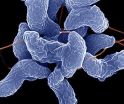Darwin's theory of gradual evolution not supported by geological history, NYU scientist concludes
2010-11-10
(Press-News.org) Charles Darwin's theory of gradual evolution is not supported by geological history, New York University Geologist Michael Rampino concludes in an essay in the journal Historical Biology. In fact, Rampino notes that a more accurate theory of gradual evolution, positing that long periods of evolutionary stability are disrupted by catastrophic mass extinctions of life, was put forth by Scottish horticulturalist Patrick Matthew prior to Darwin's published work on the topic.
"Matthew discovered and clearly stated the idea of natural selection, applied it to the origin of species, and placed it in the context of a geologic record marked by catastrophic mass extinctions followed by relatively rapid adaptations," says Rampino, whose research on catastrophic events includes studies on volcano eruptions and asteroid impacts. "In light of the recent acceptance of the importance of catastrophic mass extinctions in the history of life, it may be time to reconsider the evolutionary views of Patrick Matthew as much more in line with present ideas regarding biological evolution than the Darwin view."
Matthew (1790-1874), Rampino notes, published a statement of the law of natural selection in a little-read Appendix to his 1831 book Naval Timber and Arboriculture. Even though both Darwin and his colleague Alfred Russel Wallace acknowledged that Matthew was the first to put forth the theory of natural selection, historians have attributed the unveiling of the theory to Darwin and Wallace. Darwin's notebooks show that he arrived at the idea in 1838, and he composed an essay on natural selection as early as 1842—years after Matthew's work appeared. Darwin and Wallace's theory was formally presented in 1858 at a science society meeting in London. Darwin's Origin of Species appeared a year later.
In the Appendix of Naval Timber and Arboriculture, Matthew described the theory of natural selection in a way that Darwin later echoed: "There is a natural law universal in nature, tending to render every reproductive being the best possibly suited to its condition…As the field of existence is limited and pre-occupied, it is only the hardier, more robust, better suited to circumstance individuals, who are able to struggle forward to maturity…"
However, in explaining the forces that influenced this process, Matthew saw catastrophic events as a prime factor, maintaining that mass extinctions were crucial to the process of evolution: "...all living things must have reduced existence so much, that an unoccupied field would be formed for new diverging ramifications of life... these remnants, in the course of time moulding and accommodating ... to the change in circumstances."
When Darwin published his Origin of Species nearly three decades later, he explicitly rejected the role of catastrophic change in natural selection: "The old notion of all the inhabitants of the Earth having been swept away by catastrophes at successive periods is very generally given up," he wrote. Instead, Darwin outlined a theory of evolution based on the ongoing struggle for survival among individuals within populations of existing species. This process of natural selection, he argued, should lead to gradual changes in the characteristics of surviving organisms.
However, as Rampino notes, geological history is now commonly understood to be marked by long periods of stability punctuated by major ecological changes that occur both episodically and rapidly, casting doubt on Darwin's theory that "most evolutionary change was accomplished very gradually by competition between organisms and by becoming better adapted to a relatively stable environment."
"Matthew's contribution was largely ignored at the time, and, with few exceptions, generally merits only a footnote in modern discussions of the discovery of natural selection," Rampino concludes. "Others have said that Matthew's thesis was published in too obscure a place to be noticed by the scientific community, or that the idea was so far ahead of its time that it could not be connected to generally accepted knowledge. As a result, his discovery was consigned to the dustbin of premature and unappreciated scientific ideas."
###
END
ELSE PRESS RELEASES FROM THIS DATE:
2010-11-10
Children who have hypertension are much more likely to have learning disabilities than children with normal blood pressure, according to a new University of Rochester Medical Center (URMC) study published this week in the journal, Pediatrics. In fact, when variables such as socio-economic levels are evened out, children with hypertension were four times more likely to have cognitive problems.
"This study also found that children with hypertension are more likely to have ADHD (attention deficit hyperactivity disorder)," said Heather R. Adams, Ph.D., an assistant professor ...
2010-11-10
Boston, MA—A comprehensive review of national opinion polls shows that Americans have conflicting views about the nation's public health system and are divided along partisan lines in their support of additional spending on public health programs. A majority supports increased spending on public health in general and sees public health interventions as saving money in the long term. At the same time, however, many do not favor increased spending on a number of areas that public health officials deem important and do not see their state health department as doing a good ...
2010-11-10
CORVALLIS, Ore. – Rural and small town libraries are one of the newest forces being tapped to improve the science literacy of Americans through lifelong, "free-choice learning" opportunities in which people learn scientific, engineering and technical information somewhere other than school.
A new initiative, supported by a $2.5 million grant from the National Science Foundation, will help rural librarians tap into scientific expertise in their local communities, organize local events, provide video and other supporting materials, and essentially create adult "science ...
2010-11-10
Montreal November 9, 2010 – Potential investors might wish to examine the fingers of their financial advisor prior to signing over any savings. A new study from Concordia University has found the length between the second and fourth finger is an indicator of high levels of prenatal testosterone, risk-taking and potential financial success in men. The findings, published in the journal of Personality and Individual Differences, suggest that alpha males may take greater risks in relationships, on the squash court and in the financial market.
"Previous studies have linked ...
2010-11-10
Infrared and visible imagery from NASA's Aqua satellite today hinted that the low pressure area formerly known as Cyclone Jal may have new life soon. Jal has emerged into the warm waters of the Arabian Sea after crossing India this past weekend.
The Atmospheric Infrared Sounder (AIRS) instrument that flies onboard Aqua captured infrared and visible images of Jal's remnants on Nov. 9 at 1:30 p.m. local time/India.
Today's AIRS imagery hints that circulation is still occurring in Jal's remnants. The circulation was particularly apparent in the AIRS visible image. The ...
2010-11-10
The amount of time parents spend talking about numbers has a much bigger impact on how young children learn mathematics than was previously known, researchers at the University of Chicago have found.
For example, children whose parents talked more about numbers were much more likely to understand the cardinal number principle--which states that the size of a set of objects is determined by the last number reached when counting the set (e.g., a set of 10 items is larger than a set of seven items).
"By the time children enter preschool, there are marked individual differences ...
2010-11-10
COLUMBIA, Mo. – Depression affects approximately 30 to 40 percent of nursing home residents, but it often goes unrecognized, according to American Geriatrics Society, which can lead to lower quality of life or even suicide. Now, researchers at the University of Missouri have found a series of indicators, other than changes in mood that are associated with the development of depression in nursing home residents.
"Prompt diagnosis and treatment of depression is essential to improve the quality of life for nursing home residents," said Lorraine Phillips, assistant professor ...
2010-11-10
AURORA, Colo. (Nov. 9, 2010) – As dog bites become an increasingly major public health concern, a new study shows that unsupervised children are most at risk for bites, that the culprits are usually family pets and if they bite once, they will bite again with the second attack often more brutal than the first.
The study, the largest of its kind, was done by Vikram Durairaj, MD, of the University of Colorado School of Medicine, who found that dogs usually target a child's face and eyes and most often it's a breed considered `good' with children, like a Labrador retriever.
"People ...
2010-11-10
Killing microorganisms has become a national obsession. A pair of antimicrobial compounds known as triclosan and triclocarban are lately the weapons of choice in our war of attrition against the microbial world. Both chemicals are found in an array of personal care products like antimicrobial soaps, and triclosan also is formulated into everyday items ranging from plastics and toys to articles of clothing.
But are these antimicrobial chemicals, as commonly used by people across the nation, really safe for human health and the environment? More pointedly, do they even ...
2010-11-10
Between 20 and 30 percent of women who undergo in vitro fertilization (IVF) procedures suffer from significant symptoms of depression. Many practitioners believe that the hormone therapy involved in IVF procedures is primarily responsible for this. But new research from Tel Aviv University shows that, while this is true, other factors are even more influential.
According to Dr. Miki Bloch of Tel Aviv University's Sackler Faculty of Medicine and the Sourasky Medical Center in Tel Aviv, stress, pre-existing depression, and anxiety are more likely than hormone therapy ...
LAST 30 PRESS RELEASES:
[Press-News.org] Darwin's theory of gradual evolution not supported by geological history, NYU scientist concludes


